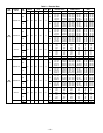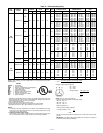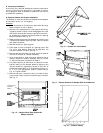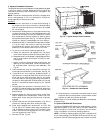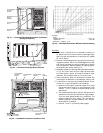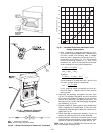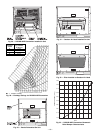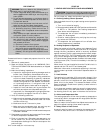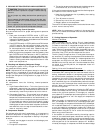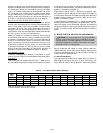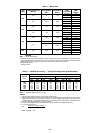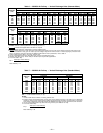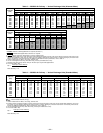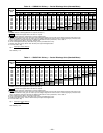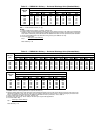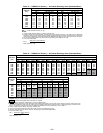
II. COOLING SECTION START-UP AND ADJUSTMENTS
CAUTION:
Complete the required procedures given
in the Pre-Start-Up section on page 17 before starting
the unit.
Do not jumper any safety devices when operating the
unit.
Do not operate the compressor when the outdoor tem-
perature is below 25 F (unless accessory low ambient
kit is installed).
Do not rapid-cycle the compressor. Allow 5 minutes be-
tween ‘‘on’’ cycles to prevent compressor damage.
A. Checking Cooling Control Operation
Start and check the unit for proper cooling control operation
as follows:
1. Place room thermostat SYSTEM switch in OFF posi-
tion. Observe that blower motor starts when FAN switch
is placed in ON position and shuts down when FAN switch
is placed in AUTO. position.
2. Place SYSTEM switch in COOL position and FAN switch
in AUTO. position. Set cooling control below room tem-
perature. Observe that compressor, condenser fan mo-
tor and evaporator-fan motor start. Observe that cool-
ing cycle shuts down when control setting is satisfied.
3. When using an auto-changeover room thermostat, place
both SYSTEM and FAN switches in AUTO. positions.
Observe that unit operates in Heating mode when tem-
perature control is set above room temperature and op-
erates in Cooling mode when temperature control is set
below room temperature.
B. Checking and Adjusting Refrigerant Charge
The refrigerant system is fully charged with R-22 refriger-
ant, tested and factory-sealed.
NOTE: Adjustment of the refrigerant charge is not required
unless the unit is suspected of not having the proper R-22
charge. This unit uses charging charts to determine proper
charge. See Refrigerant Charge section on page 30 for fur-
ther details.
C. Unit Controls
All compressors have the following internal-protection
controls:
1. High-Pressure Relief Valve — This valve (internal to the
compressor) opens when the pressure differential be-
tween the low and high sides becomes excessive and will
automatically reset when pressure returns to normal.
2. Compressor Overload — This overload interrupts power
to the compressor when either the current or internal
temperature becomes excessive, and automatically re-
sets when the internal temperature drops to a safe level.
This overload may require up to 60 minutes (or longer)
to reset; therefore, if the internal overload is suspected
of being open, disconnect the electrical power to the unit
and check the circuit through the overload with an ohm-
meter or continuity tester.
D. Compressor Rotation
On 3-phase units with scroll compressors, it is important to
be certain compressor is rotating in the proper direction. To
determine whether or not compressor is rotating in the proper
direction:
1. Connect service gages to suction and discharge pres-
sure fittings.
2. Energize the compressor.
3. The suction pressure should drop and the discharge pres-
sure should rise, as is normal on any start-up.
If the suction pressure does not drop and the discharge pres-
sure does not rise to normal levels:
1. Note that the evaporator fan is probably also rotating
in the wrong direction.
2. Turn off power to the unit.
3. Reverse any two of the unit power leads.
4. Reapply power to the compressor.
The suction and discharge pressure levels should now move
to their normal start-up levels.
NOTE: When the compressor is rotating in the wrong direc-
tion, the unit makes an elevated level of noise and does not
provide cooling.
E. Cooling Sequence of Operation
Without Economizer
Room thermostat calls for cooling. Circuit closes between
24-v control circuit terminals R and Y1 and terminals R and
G. Power to terminal R is supplied through the 24-v trans-
former (transformer is internally protected against over-
load). Terminal G energizes the indoor (evaporator) fan con-
tactor (IFC) through normally closed contacts T and B of the
time-delay relay (TDR) and the evaporator fan starts.
The 24-v power through terminal Y1 energizes the compres-
sor contactor (C), starting the compressor and condenser fan.
When the thermostat is satisfied, C1 is deenergized and the
compressor and OFM shut off. After a 30-second delay on
036-060 units, the IFM shuts off. If the thermostat fan selec-
tor switch is in the ON position, the evaporator motor will
run continuously.
Cooling, Units with Durablade Economizer
When the outdoor-air temperature is above the outdoor-air
thermostat (OAT) setting and the room thermostat calls for
cooling, compressor contactor is energized to start compres-
sor and the outdoor (condenser) fan motor (OFM). The indoor
(evaporator) fan motor (IFM) is energied and the economizer
damper moves to the minimum position. After the thermo-
stat is satisfied, there is a 30-second delay before the evapo-
rator fan turns off. The damper then moves to the fully closed
position. When using continuous fan, the damper moves to
the minimum position.
When the outdoor-air temperature is below the OAT setting
and the thermostat calls for cooling, the economizer damper
moves to the minimum position. If the supply-air tempera-
ture is above 57 F, the damper continues to open until it reaches
the fully open position or until the supply-air temperature
drops below 52 F.
When the supply-air temperature falls to between 57 F and
52 F, the damper will remain at an intermediate open posi-
tion. If the supply-air temperature falls below 52 F, the damper
will modulate closed until it reaches the minimum position
or until the supply-air temperature is above 52 F. When the
thermostat is satisfied, the damper moves to the fully closed
position when using AUTO. fan or to the minimum position
when using a continuous fan.
If the outdoor air alone cannot satisfy the cooling require-
ments of the conditioned space, economizer cooling is inte-
grated with mechanical cooling, providing two stages of cool-
ing. The compressor and the condenser fan will be energized
and the position of the economizer damper will be deter-
mined by the supply-air temperature. When the second stage
—18—



